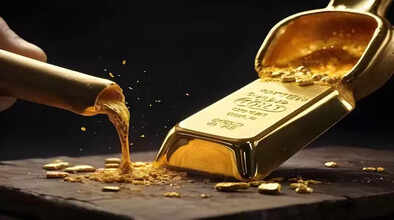Gold Silver Price Update: Gold Down ₹13,000 from Record High, Silver Falls ₹23,000 — What’s Next for Investors?

📉 Gold and Silver Prices Slip Sharply
Gold prices have fallen nearly ₹13,000 from their record high of ₹1,32,294 per 10 grams, while silver has dropped about ₹23,000 per kg. Ahead of the US Federal Reserve’s monetary policy announcement, the market is showing signs of caution, even as the Reserve Bank of India (RBI) has increased its gold reserves.
On Wednesday, October 29, December delivery gold futures on the Multi Commodity Exchange (MCX) fell to ₹1,19,351 per 10 grams, down from Tuesday’s closing of ₹1,19,646. This marks the fourth consecutive session of decline.
📊 Four Days of Consecutive Decline
Gold futures touched a day’s high of ₹1,21,127 per 10 grams but eventually dropped, continuing their four-day losing streak. The metal has now corrected sharply from its all-time peak amid global market uncertainty and a stronger dollar.
⚙️ Silver Shows Mild Recovery
In contrast, December silver futures showed slight recovery, climbing over 2% to ₹1,47,547 per kg at the day’s high, compared to Tuesday’s close of ₹1,44,342 per kg. However, silver still remains nearly ₹23,000 below its record level of ₹1,70,415 per kg.
🌍 Global Market Trends
A similar trend was seen globally. On COMEX, December gold fell $15.9 (0.4%) to $3,967.2 per ounce, marking its fourth straight day of losses. Meanwhile, December silver rose 0.32% to $47.47 per ounce.
In the Delhi bullion market, gold prices dipped ₹4,100 to settle at ₹1,21,800 per 10 grams, amid reduced safe-haven demand as US-China trade tensions eased.
Spot gold also slipped below the $4,000 psychological level, trading at $3,887.03 per ounce, while spot silver dropped 2.85% to $45.56 per ounce.
🪙 Why Are Gold Prices Falling?
Typically, gold prices rise during periods of economic uncertainty or geopolitical tension. However, renewed optimism over a potential US-China trade deal has reduced investor demand for safe-haven assets.
According to reports, US President Donald Trump and Chinese President Xi Jinping are expected to meet during the APEC Summit in South Korea, where discussions may include rare earth materials, US tariffs, TikTok, agriculture, and fentanyl trade.
This growing optimism has led investors to shift away from gold and into riskier assets.
💰 Gold-Based ETF Outflows
Praveen Singh, Head of Commodities and Currency at Mirae Asset Sharekhan, noted that “investors are exiting safe-haven assets as confidence in the US-China trade deal increases.”
He added that gold-based ETFs saw continuous outflows for the third day on October 24, putting further pressure on prices.
Markets now await the Federal Open Market Committee (FOMC) decision, where a 25 basis points interest rate cut is widely expected.
📈 Despite Dip, Long-Term Outlook Remains Strong
Despite recent declines, both gold and silver are still on track to end October with monthly gains, having surged over 50% so far this year.
Central banks around the world continue to buy gold to hedge against inflation and currency risk. Countries like India and China aim to reduce dependence on the dollar-based global financial system.
The RBI has increased its gold reserves by 25.45 metric tonnes as of September 2025, bringing its total to 880.18 metric tonnes, with 575.82 tonnes held domestically. The share of gold in India’s foreign exchange reserves has risen from 11.7% in March 2025 to 13.92% in September 2025.
💡 Should You Invest in Gold Now?
Experts suggest that while prices have corrected, investors should avoid panic selling. The long-term fundamentals for gold remain strong, supported by central bank demand and persistent inflation risks.
However, new investors may wait for further market clarity post-Fed policy announcement before entering fresh positions.
Disclaimer: The investment opinions and recommendations mentioned are those of market experts and brokerage firms. Readers are advised to consult a certified financial advisor before making any investment decisions.

